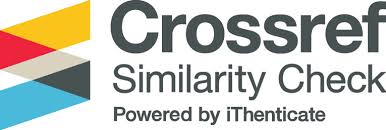Standardization Of Khaya (Khaya anthotheca) Extract As Breast Anticancer MCF-7 (Michigan Cancer Foundation-7)
Abstract
Cancer is the second non-communicable disease that causes the largest number of deaths after cardiovascular disease. The chemical compounds contained in the Khaya anthotheca plant and which have anticancer activity include methyl angolensate, 7-deacetylhivorin, grandifolione, gedunin, , obacunone and Cathecin. This research aims to determine the standardization of extracts and determine anticancer activity against MCF-7 breast cancer cells. The method used in this research is standardization of specific and non-specific parameters, and cytotoxic testing using Prestoblue. The results of extract standardization of specific parameters have values for soluble essence in water and ethanol of 4.68% and 5.80% (meeting the requirements). Non-specific parameters drying loss 0.739%, ash content 8.02%, microbial contamination 0 colonies, lead (Pb) 0.2976 mg/kg, cadmium (Cd) ≤0.001 mg/kg (qualified) and IC₅₀ value of anticancer activity breast MCF-7 from Khaya anthoteca extract was 194.20 µg/mL in the medium/moderate category
References
[2] Kemenkes RI. “Profil Kesehatan Indonesia 2021”. In Pusdatin.Kemenkes.go.id. 2021.
[3] Kemenkes RI. “Hasil Riset Kesehatan Dasar Tahun 2018. Kementerian Kesehatan RI”. Vol 53, No. 9.pp 1689–1699. 2018.
[4] Hosseini, A., dan Ghorbani, A.. “Cancer therapy With Phytochemicals: Evidence From Clinical Studies”. Avicenna Journal of Phytomedicine, 5(2), pp. 84–97. 2015.
[5] Zafrial, R. M., dan Amalia, R.. Artikel Tinjauan : Anti Kanker Dari Tanaman Herbal. Farmaka. Vol 16, No.1, pp 15–23. 2018.
[6] Chiruvella, K., Nishana, M., Gopalakrishnan, V., Ranganatha, S., Tadi, S., Choudhary, B., and Raghavan, S. “Plant-derived Tetranortriterpenoid, Methyl Angolensate Activates Apoptosis and Prevents Ehrlich Ascites Carcinoma Induced Tumorigenesis in Mice”. British Journal of Medicine and Medical Research, Vol.12, No.11, pp 1–10. 2016.
[7] Zhang, W. Y., Qiu, L., Lu, Q. P., Zhou, M. M., Luo, J., and Li, Y. “Furan fragment isomerized mexicanolide-type Limonoids from the stem barks of Khaya senegalensis”. Phytochemistry Letters. Vol. 24, No.17, pp. 110–113. 2018.
[8] Luo, X., Yu, Z., Yue, B., Ren, J., Zhang, J., Mani, S., Wang, Z., and Dou, W. “Obacunone reduces inflammatory signalling and tumour occurrence in mice with chronic inflammation-induced colorectal cancer”. Pharmaceutical Biology. Vol.58, No. 1, pp. 886–897. 2020.
[9] Braga, T. M., Rocha, L., Chung, T. Y., Oliveira, R. F., Pinho, C., Oliveira, A. I., Morgado, J., and Cruz, A. Biological activities of gedunin—A limonoid from the Meliaceae family. Molecules. Vol. 25, No. 3, pp. 9–11. 2020.
[10] Sari, L. M. “Catechin : Molecular Mechanism of Anti-Cancer Effect”. Dentika Dental Journal, Vol. 22, No.1, pp. 20–25. 2019.
[11] Maryam, F., Taebe, B., and Toding, D. P. “Pengukuran Parameter Spesifik Dan Non Spesifik Ekstrak Etanol Daun Matoa (Pometia ponnata J.R & G.Forst)”. Jurnal Mandala Pharmacon Indonesia, Vol. 6, No.1, pp. 1–12. 2020.
[12] Kementerian Kesehatan RI. “Farmakope Herbal Indonesia Herbal edisi II. Pocket Handbook of Nonhuman Primate Clinical Medicine”, pp. 307–310. 2017.
[13] Depkes, R. “Parameter Standar Umum Ekstrak Tumbuhan Obat”. 2000.
[14] Tjampakasari, C. R., Kiranasari, A., dan Ningsih, I. “Microbial Contamination in Processed Food According to Indonesian National Standards and The food and Drug Supervisory Agency at The Microbiology”. European Journal of Molecular &Clinical, Vol. 08, No.03, pp. 2515–8260. 2021.
[15] Najib, A., Malik, A., Ahmad, A. R., Handayani, V., Syarif, R. A., dan Waris, R. “Standardisasi Ekstrak Air Daun Jati Belanda dan Daun Jati Hijau”. Jurnal Fitofarmaka Indonesia, Vol. 4, No.2, pp 241–245. 2018.
[16] BPOM RI. “Persyaratan Keamanan dan Mutu Obat Alam”. Badan Pengawas Obat Dan Makanan, Vol. 11, pp. 1–16. 2023.
[17] Indarto., Narulita, W., Anggoro, B. S., dan Novitasari, A. “Aktivitas Antibakteri Ekstrak Daun Binahong Terhadap Propionibacterium acnes”. Biosfer Jurnal Tadris Biologi. Vol. 10, No. 1, pp67-78. 2019.
[18] Verdiana, M., Widarta, I. W.R., dan Permana, I. D. G. M. 2018. “Pengaruh Jenis Pelarut Pada Ekstraksi Menggunakan Gelombang Ultrasonik Terhadap Aktivitas Antioksidan Ekstrak Kulit Buah Lemon (Citrus limon (Linn.) Burm F.)”. Jurnal Ilmu dan Teknologi Pangan. Vol. 7, No. 4, pp 213-222. 2018.
[19] Megawati., Fajriah, S., Meilawati, L., Supriadi, E., dan Widiyarti, G. “Kandungan Fenolik dan Flavonoid Total Daun Macaranga hispida (Blume) Mull. Arg sebagai Kandidat Obat Antidiabetes”. Jurnal Kefarmasian Indonesia. Vol. 11, No. 1, pp1-7. 2021.
[20] Salamah., N. Rozak., dan MAl Abror M. “Pengaruh metode penyarian terhadap kadar alkaloid total daun jembirit (Tabernaemontana sphaerocarpa. BL) dengan metode spektrofotometri visibel”. Pharmaciana. Vol. 7, No. 1,pp. 113. 2017.
[21] Idroes, R., Khairan., Nurisma, N. W., Wawaddah, N., Pradysta, R. R. G., dan Rofina. 2019. “Skrining Aktivitas Tumbuhan Yang Berpotensi Sebagai Bahan Antimikroba Di Kawasan IE Brok (Upflow Geothermal Zone) Aceh Besar”. Syiah Kuala University Press. Aceh.
[22] Rosyidah, H. Standardisasi Ekstrak Etil Asetat Anting-Anting (Acalypha Indica Linn.) Sebagai Herba Antimalaria. Skripsi. Univesitas Islam Negeri Malang. 2016
[23] Aslanturk, O. S. “In Vitro Cytotoxicity and Cell Viability Assays: Principles, Advantages, and Disadvantages”. Intechopen. Pp. 1–17. 2018.
[24] Syahputra, G. Resazurin si indikator aktivitas sel. Bio Trends, Vol. 6, No.2, pp 26–28. 2015.
[25] Rachmawati, E., Karyono, S., dan Suyuti, H. “Efek Ekstrak Etanolik Daun Sirsak pada Proliferasi dan Apoptosis Sel HeLa yang Dimediasi oleh p53 The Effect of Annona Muricata Leaf on Proliferation and Appoptosis of HeLa Cells Mediated by p53”. Jurnal Kedokteran Brawijaya, Vol. 27, No.1, pp 28–33. 2012.
[26] Csepregi, R., Lemli, B., Kunsági-Máté, S., Szente, L., Koszegi, T., Németi, B., and Poór, M. “Complex formation of resorufin and resazurin with b-cyclodextrins: Can cyclodextrins interfere with a resazurin cellviability assay”. Molecules, Vol. 23, No. 2, pp. 3–16. 2018.
[27] Sajjadi, S. E., Ghanadian, M., Haghighi, M., and Mouhebat, L. “Cytotoxic effect of Cousinia verbascifolia Bunge against OVCAR-3 and HT-29 cancer cells”. Journal of HerbMed Pharmacology, Vol. 4, No. 1, pp.15–19. 2015.













